Design and Implementation of Novel Testing System for Intelligent Tire Development: From Bench to Road
Abstract
1. Introduction
- Full lifecycle testing with dynamic road support;
- Extensive data collection on tire performance, dynamic wheel forces, vehicle motions, and driving behaviors;
- High-performance data acquisition enabled by a modular and distributed architecture.
2. Background and Design Requirements
2.1. Sensing Principles and Methodologies for Intelligent Tires
2.2. Parameters of Interest in Intelligent Tire Testing
2.3. Development Stages and Corresponding Testing Needs
2.4. Summary of Design Requirements
- The Complete Integration of Tire Measurement Parameters: This ensures the comprehensive measurement of tire-related information, including tire force information (e.g., vertical and lateral forces), tire–vehicle motion dynamics (e.g., speed, cornering, slip), basic in-tire conditions (e.g., pressure and temperature), and raw sensor signals (e.g., accelerometers, strain gauges, PVDF sensors). This guarantees that all relevant factors affecting tire performance are captured and considered during the testing process.
- High-Frequency Multi-Channel Sampling for Core Tire Sensors with Cross-Sensor Synchronization: The sampling frequency of the core tire sensors (typically recommended to be no less than 2 kHz, with this study adopting 50 kHz) must meet the requirements for frequency-domain analysis and capture critical sensor characteristics by providing sufficient samples per tire rotation, even at high rotation speeds (e.g., at 120 km/h, a 2 kHz sampling rate provides 116 samples per rotation for a 205/55 R16 tire). Furthermore, synchronization with other sensors operating at varying frequencies is essential. For example, in-tire accelerometers and PVDF sensors typically operate in the kilohertz range, vehicle motion sensors in the tens of Hz, and tire pressure and temperature sensors at much lower frequencies, typically below 1 Hz. Adopting a hardware-level synchronization mechanism, such as an FPGA (Field-Programmable Gate Array), is critical to ensure their accurate integration.
- Modular and Flexible Design for Functional Expansion and Seamless Integration with Vehicle Systems: The system should be easily reconfigurable for various testing scenarios (e.g., bench tests, road validation, product testing) and include reserved interfaces (e.g., a standardized CAN bus) for seamless integration with additional sensors and vehicle systems.
- Efficient Data Processing and Real-Time Performance Achieved Using a Distributed Architecture: This facilitates the efficient processing of large datasets, such as those required for machine learning, while ensuring real-time performance across sensors. A distributed architecture is essential to effectively allocate tasks, providing greater computational power and storage efficiency at higher processing levels while maintaining real-time performance at the sensor interface and data acquisition levels.
- Robustness and Durability: These ensure reliable performance in harsh testing environments, including when high temperatures, vibrations, and mechanical stresses are experienced within the tire.
3. System Design
3.1. Overall System Architecture
3.2. Instrumented Wheel Assembly
- Intelligent Tire Sensors: Multiple IEPE triaxial accelerometers and PVDF sensors are strategically mounted on the tire’s inner liner to capture their response characteristics under varying operating conditions. Their placement supports the investigation of positional and orientational effects, as well as the interrelationships between different sensing modalities.
- Tire Pressure and Temperature Sensor: To ensure higher accuracy and greater real-time monitoring compared to a conventional TPMS, a combined thin-film pressure and temperature sensor (PCM167, EFE Sensors, Goleta, CA, USA), integrating a Resistance Temperature Detector (RTD) Pt-1000 element, is incorporated into the modified wheel rim to measure the in-tire pressure and temperature.
- Slip Ring with Rotational Sensor: To manage the substantial data generated by these sensors, a slip ring is employed to maintain a wired connection, ensuring superior reliability, bandwidth, and real-time data transmission in harsh working environments. Additionally, the slip ring is integrated with a rotational sensor that provides wheel rotation angle data via quadrature-encoded pulses. These data are crucial for the accurate determination of the wheel speed and angular position of the in-tire sensors, enabling precise synchronization with other system components.
3.3. Integration with WFT System
3.4. Vehicle Motion and Driving Behavior Sensing
3.5. Data Acquisition and Processing Unit
- FPGA layer: The FPGA is responsible for real-time data acquisition and synchronization. Each sensor type operates in an independent while loop, leveraging the FPGA’s parallel processing capabilities to ensure reliable and efficient performance. High-frequency data acquisition is synchronized using the NI 9229 module’s internal master time base. All data streams are timestamped at the FPGA level, enabling alignment during post-processing.
- RT layer: The RT layer bridges the FPGA and the host PC, handling preliminary data processing and data transfer. Communication between the FPGA and RT is facilitated by FIFOs, while queues ensure reliable and lossless transmission to the host PC. The RT also supports GPS signal acquisition in an NMEA format via Ethernet, utilizing the Ethernet interface integrated into the RT controller hardware.
- Host PC: The host PC implements a state machine to manage user interactions, advanced data analysis, and logging. Data are stored in a Technical Data Management Streaming (TDMS) format, allowing for efficient organization, metadata tagging, and streamlined access for analysis.
- Synchronization and task parallelization: Synchronization across all layers is achieved using FPGA-assigned timestamps, ensuring the precise alignment of high-frequency and low-frequency signals. Each major task—whether data acquisition, pre-processing, or logging—is executed in an independent while loop, enhancing reliability, real-time performance, and logical clarity.
4. Bench Test
4.1. Experimental Setup
4.2. Data Acquisition and Integrity
4.3. Vertical Load Estimation Analysis
4.4. Summary of Bench Test Results
5. Road Test
5.1. Experimental Setup and Hardware Architecture
5.2. Data Acquisition and Analysis
6. Conclusions
6.1. Summary of Testing System Design and Functionality
6.2. Potential for Future Research and Applications
- Road Validation and Practical Deployment: The system’s adaptability to real-world testing facilitates the validation of laboratory results across diverse scenarios, bridging the gap between research and practical application.
- The Exploration of Additional Tire Characteristics: Leveraging a modular and extensible design, the system allows for the easy integration of additional sensors, enabling the exploration of new tire characteristics and sensor types.
- The Optimization of Sensing Methods: The multi-channel, multi-sensor setup facilitates the optimization of sensing configurations, sensor placement, and data fusion techniques across multiple sensor types, thereby improving the measurement accuracy and overall performance.
- Integration with Vehicle Systems: By synchronously capturing high-fidelity vehicle dynamics and driver behavior data, the system establishes a robust foundation for integrating intelligent tire sensing into vehicle control systems, thereby advancing applications such as ADAS and autonomous driving.
Author Contributions
Funding
Institutional Review Board Statement
Informed Consent Statement
Data Availability Statement
Acknowledgments
Conflicts of Interest
Abbreviations
| WFT | Wheel force transducer |
| PVDF | Polyvinylidene Fluoride |
| FPGA | Field-Programmable Gate Array |
| RT | Real-time controller |
| PC | Personal Computer |
| IEPE | Integrated Electronics Piezoelectric |
| TPMS | Tire Pressure Monitoring System |
| RTD | Resistance Temperature Detector |
| GPS | Global Positioning System |
| IMU | Inertial Measurement Unit |
| CAN | Controller Area Network |
| RTK | Real-Time Kinematic |
| TDMS | Technical Data Management Streaming |
| SVM | Support Vector Machine |
| RBF | Radial basis function |
| MAPE | Mean Absolute Percentage Error |
| ITTU | Intelligent Tire Test Unit |
References
- Xiong, Y.; Yang, X. A review on in-tire sensor systems for tire-road interaction studies. Sens. Rev. 2018, 38, 231–238. [Google Scholar] [CrossRef]
- Xu, N.; Huang, Y.; Askari, H.; Tang, Z. Tire Slip Angle Estimation Based on the Intelligent Tire Technology. IEEE Trans. Veh. Technol. 2021, 70, 2239–2249. [Google Scholar] [CrossRef]
- Xu, N.; Tang, Z.; Askari, H.; Zhou, J.; Khajepour, A. Direct tire slip ratio estimation using intelligent tire system and machine learning algorithms. Mech. Syst. Signal Process. 2022, 175, 109085. [Google Scholar] [CrossRef]
- Barbosa, B.H.G.; Xu, N.; Askari, H.; Khajepour, A. Lateral Force Prediction Using Gaussian Process Regression for Intelligent Tire Systems. IEEE Trans. Syst. Man Cybern. Syst. 2022, 52, 5332–5343. [Google Scholar] [CrossRef]
- Lee, D.; Kim, J.C.; Kim, M.; Lee, H. Intelligent tire sensor-based real-time road surface classification using an artificial neural network. Sensors 2021, 21, 3233. [Google Scholar] [CrossRef]
- Mishra, S.; Liang, J.M. Design and Implementation of Energy-Efficient Wireless Tire Sensing System with Delay Analysis for Intelligent Vehicles. IEEE Trans. Intell. Veh. 2024; early access. [Google Scholar] [CrossRef]
- Sun, X.; Tao, X.; Quan, Z.; Gu, T. Path tracking and stability control of autonomous vehicles based on intelligent tires technology. Proc. Inst. Mech. Eng. Part D J. Automob. Eng. 2025; early access. [Google Scholar]
- Yang, S.; Chen, Y.; Shi, R.; Wang, R.; Cao, Y.; Lu, J. A Survey of Intelligent Tires for Tire-Road Interaction Recognition Toward Autonomous Vehicles. IEEE Trans. Intell. Veh. 2022, 7, 520–532. [Google Scholar] [CrossRef]
- Leng, B.; Tian, C.; Hou, X.; Xiong, L.; Zhao, W.; Yu, Z. Tire-Road Peak Adhesion Coefficient Estimation Based on Multisource Information Assessment. IEEE Trans. Intell. Veh. 2023, 8, 3854–3870. [Google Scholar] [CrossRef]
- Chen, W.; Tan, D.; Zhao, L. Vehicle Sideslip Angle and Road Friction Estimation Using Online Gradient Descent Algorithm. IEEE Trans. Veh. Technol. 2018, 67, 11475–11485. [Google Scholar] [CrossRef]
- Quan, Z.; Li, B.; Bei, S.; Sun, X.; Xu, N.; Gu, T. Tire-road friction coefficient estimation method design for intelligent tires equipped with PVDF piezoelectric film sensors. Sens. Actuators A Phys. 2023, 349, 114007. [Google Scholar] [CrossRef]
- Kim, H.J.; Han, J.Y.; Lee, S.; Kwag, J.R.; Kuk, M.G.; Han, I.H.; Kim, M.H. A road condition classification algorithm for a tire acceleration sensor using an artificial neural network. Electronics 2020, 9, 404. [Google Scholar] [CrossRef]
- Gupta, U.; Nouri, A.; Subramanian, C.; Taheri, S.; Kim, M.T.; Lee, H. Developing an Experimental Setup for Real-Time Road Surface Identification Using Intelligent Tires. SAE Int. J. Veh. Dyn. Stab. NVH 2021, 5, 351–367. [Google Scholar] [CrossRef]
- Bowen, C.R.; Arafa, M.H. Energy harvesting technologies for tire pressure monitoring systems. Adv. Energy Mater. 2015, 5, 1401787. [Google Scholar] [CrossRef]
- Shen, D.; Cao, J.; Liu, P.; Guo, J. Intelligent recognition system of in-service tire damage driven by strong combination augmentation and contrast fusion. Neural Comput. Appl. 2025, 37, 5795–5813. [Google Scholar] [CrossRef]
- Xu, N.; Wang, Z.; Askari, H.; Barbosa, B.H.G.; Khajepour, A. Intelligent mobility: Unveiling triboelectric nanogenerator-powered intelligent tire realization. Appl. Mater. Today 2025, 42, 102506. [Google Scholar] [CrossRef]
- Coiret, A.; Fontaine, M.; Cesbron, J.; Baltazart, V.; Betaille, D.; Coudouel, D.; Léa, E. Vehicle wheel load estimation with fiber optical contact patch elongation measurement. Road Rail Infrastruct. VI 2021, 6, 781–788. [Google Scholar] [CrossRef]
- Yue, Y.; Li, X.; Zhao, Z.; Wang, H.; Guo, X. Stretchable flexible sensors for smart tires based on laser-induced graphene technology. Soft Sci. 2023, 3, 13. [Google Scholar] [CrossRef]
- Xu, N.; Askari, H.; Huang, Y.; Zhou, J.; Khajepour, A. Tire Force Estimation in Intelligent Tires Using Machine Learning. IEEE Trans. Intell. Transp. Syst. 2022, 23, 3565–3574. [Google Scholar] [CrossRef]
- Jeong, D.; Choi, S.B.; Lee, J.; Kim, M.; Lee, H. Tire dimensionless numbers for analysis of tire characteristics and intelligent tire signals. Mech. Syst. Signal Process. 2021, 161, 107927. [Google Scholar] [CrossRef]
- Nishiyama, K.; Takedomi, S.; MacHida, Y.; Yokoo, A.; Kamiyama, M.; Ichikawa, H.; Mori, T. Intelligent Tire Algorithm Enabling Simultaneous Detection of Loading and Wear Status of Truck and Bus Tires. In Proceedings of the 2023 IEEE World Forum on Internet of Things: The Blue Planet: A Marriage of Sea and Space, WF-IoT 2023, Aveiro, Portugal, 12–27 October 2023. [Google Scholar] [CrossRef]
- Gupta, U.; Gorantiwar, A.; Taheri, S. Real time tire wear detection using intelligent tires. In Proceedings of the ASME 2023 International Mechanical Engineering Congress and Exposition 2023, New Orleans, LA, USA, 29 October–2 November 2023; Volume 13. [Google Scholar] [CrossRef]
- Tong, Z.; Cao, Y.; Wang, R.; Chen, Y.; Li, Z.; Lu, J.; Yang, S. Machine learning-driven intelligent tire wear detection system. Meas. J. Int. Meas. Confed. 2025, 242, 115848. [Google Scholar] [CrossRef]
- Park, H.; Seo, J.; Kim, K.; Kim, T. Predicting the Wear Amount of Tire Tread Using 1D-CNN. Sensors 2024, 24, 6901. [Google Scholar] [CrossRef] [PubMed]
- Mendoza-Petit, M.F.; García-Pozuelo, D.; Díaz, V.; Olatunbosun, O. A strain-based intelligent tire to detect contact patch features for complex maneuvers. Sensors 2020, 20, 1750. [Google Scholar] [CrossRef] [PubMed]
- Mendoza-Petit, M.F.; Garcia-Pozuelo, D.; Diaz, V.; Garrosa, M. Characterization of the loss of grip condition in the Strain-Based Intelligent Tire at severe maneuvers. Mech. Syst. Signal Process. 2022, 168, 108586. [Google Scholar] [CrossRef]
- Garcia-Pozuelo, D.; Yunta, J.; Olatunbosun, O.; Yang, X.; Diaz, V. A strain-based method to estimate slip angle and tire working conditions for intelligent tires using fuzzy logic. Sensors 2017, 17, 874. [Google Scholar] [CrossRef]
- Yunta, J.; Garcia-Pozuelo, D.; Diaz, V.; Olatunbosun, O. A strain-based method to detect tires’ loss of grip and estimate lateral friction coefficient from experimental data by fuzzy logic for intelligent tire development. Sensors 2018, 18, 490. [Google Scholar] [CrossRef]
- Bastiaan, J.; Chawan, A.; Eum, W.; Alipour, K.; Rouhollahi, F.; Behroozi, M.; Baqersad, J. Intelligent Tire Prototype in Longitudinal Slip Operating Conditions. Sensors 2024, 24, 2681. [Google Scholar] [CrossRef]
- Sun, X.; Quan, Z.; Cai, Y.; Chen, L.; Li, B. Direct Tire Slip Angle Estimation Using Intelligent Tire Equipped with PVDF Sensors. IEEE/ASME Trans. Mechatron. 2024; early access. [Google Scholar] [CrossRef]
- Breglio, G.; Irace, A.; Pugliese, L.; Riccio, M.; Russo, M.; Strano, S.; Terzo, M. Development and testing of a low-cost wireless monitoring system for an intelligent tire. Machines 2019, 7, 49. [Google Scholar] [CrossRef]
- Sun, X.; Quan, Z.; Cai, Y.; Chen, L.; Li, B. Intelligent Tire Slip Angle Estimation Based on Sensor Targeting Configuration. IEEE Trans. Instrum. Meas. 2024, 73, 1–16. [Google Scholar] [CrossRef]
- Li, B.; Quan, Z.; Bei, S.; Zhang, L.; Mao, H. An estimation algorithm for tire wear using intelligent tire concept. Proc. Inst. Mech. Eng. Part D J. Automob. Eng. 2021, 235, 2712–2725. [Google Scholar] [CrossRef]
- Ji, W.; Yu, Y.; Li, R.; Tian, G.; Lu, Z. A Design of Intelligent Tire Prototype Based on Multiple Accelerometers. In Proceedings of the 2023 7th CAA International Conference on Vehicular Control and Intelligence, CVCI 2023, Changsha, China, 27–29 October 2023; pp. 1–6. [Google Scholar] [CrossRef]
- Coppo, F.; Pepe, G.; Roveri, N.; Carcaterra, A. A multisensing setup for the intelligent tire monitoring. Sensors 2017, 17, 576. [Google Scholar] [CrossRef]
- Min, D.; Wei, Y.; Zhao, T.; He, J. A fusion estimation of tire vertical forces using model-based tire state estimators for a dual-sensor intelligent tire. Proc. Inst. Mech. Eng. Part D J. Automob. Eng. 2023, 238, 2146–2159. [Google Scholar] [CrossRef]
- Feng, L.; Jia, L.; Wang, D.; Wang, H.; Wang, S.; Xiong, P.; Song, A. An Intuitively Derived Decoupling and Calibration Model to the Multiaxis Force Sensor Using Polynomials Basis. IEEE Sens. J. 2024, 24, 9514–9522. [Google Scholar] [CrossRef]
- Feng, L.; Wang, S.; Shi, J.; Xiong, P.; Chen, C.; Xiao, D.; Song, A.; Liu, P.X. An Interpretable Nonlinear Decoupling and Calibration Approach to Wheel Force Transducers. IEEE Trans. Intell. Transp. Syst. 2024, 25, 225–236. [Google Scholar] [CrossRef]
- Feng, L.; Chen, W.; Cheng, M.; Zhang, W. The gravity-based approach for online recalibration of wheel force sensors. IEEE/ASME Trans. Mechatron. 2020, 24, 1686–1697. [Google Scholar] [CrossRef]
- Feng, L.; Chen, W.; Wu, T.; Wang, H.; Dai, D.; Wang, D.; Zhang, W. An improved sensor system for wheel force detection with motion-force decoupling technique. Meas. J. Int. Meas. Confed. 2018, 119, 205–217. [Google Scholar] [CrossRef]
- Feng, L.; Lin, G.; Zhang, W.; Pang, H.; Wang, T. Design and optimization of a self-decoupled six-axis wheel force transducer for a heavy truck. Proc. Inst. Mech. Eng. Part D J. Automob. Eng. 2015, 229, 1585–1610. [Google Scholar] [CrossRef]
- Larsen, H.W.; Talaski, C.E. Multi-Axis Wheel Load Transducer. US6324919B1, 4 December 2001. [Google Scholar]
- Tao, L.; Zhang, D.; Zhang, X.; Pan, D.; Zhan, Q. Design and Experiments of Special Rim Assembly for Intelligent Tire Development Platform. Zhongguo Jixie Gongcheng/China Mech. Eng. 2023, 34, 1111–1119. [Google Scholar] [CrossRef]
- Tao, L.; Tang, Y.; Li, Y.; Zhang, D.; Zhang, X. Design of Intelligent Tire Development Platform with Multiple In-tire Sensors and Research on Tire Cornering Test. Jixie Gongcheng Xuebao/J. Mech. Eng. 2024, 60, 245–255. [Google Scholar]
- Zhang, X.; Chen, B.; Song, J.; Wang, Q. Test method research on vehicle’s tire side slip angle in extreme driving conditions. Nongye Jixie Xuebao/Trans. Chin. Soc. Agric. Mach. 2014, 45, 31–36. [Google Scholar] [CrossRef]
- Wu, T.; Zhang, X.; Wang, D.; Zhang, W.; Pan, D.; Tao, L. Comparative Study and Real-World Validation of Vertical Load Estimation Techniques for Intelligent Tire Systems. Sensors 2025, 25, 2100. [Google Scholar] [CrossRef]
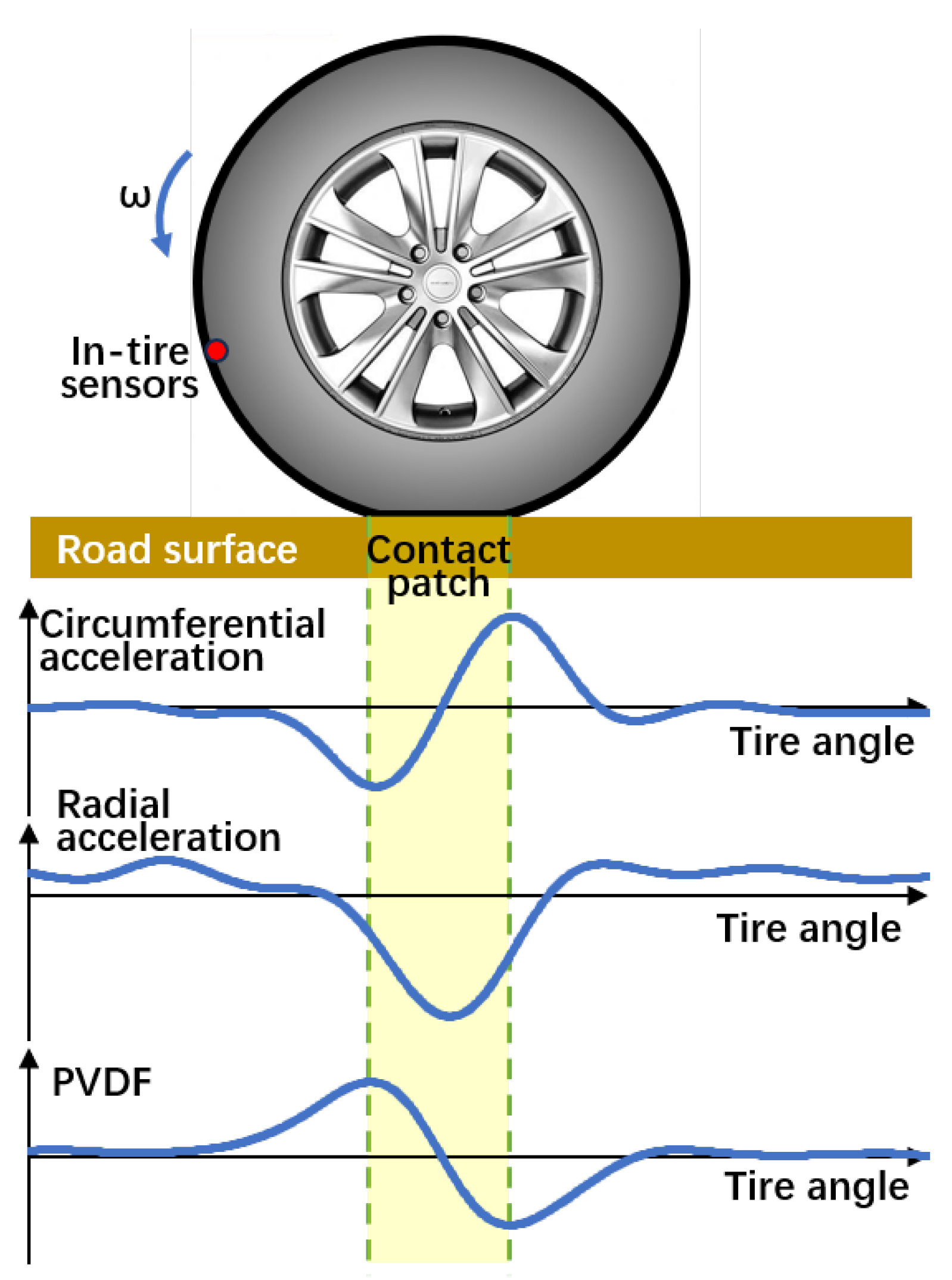
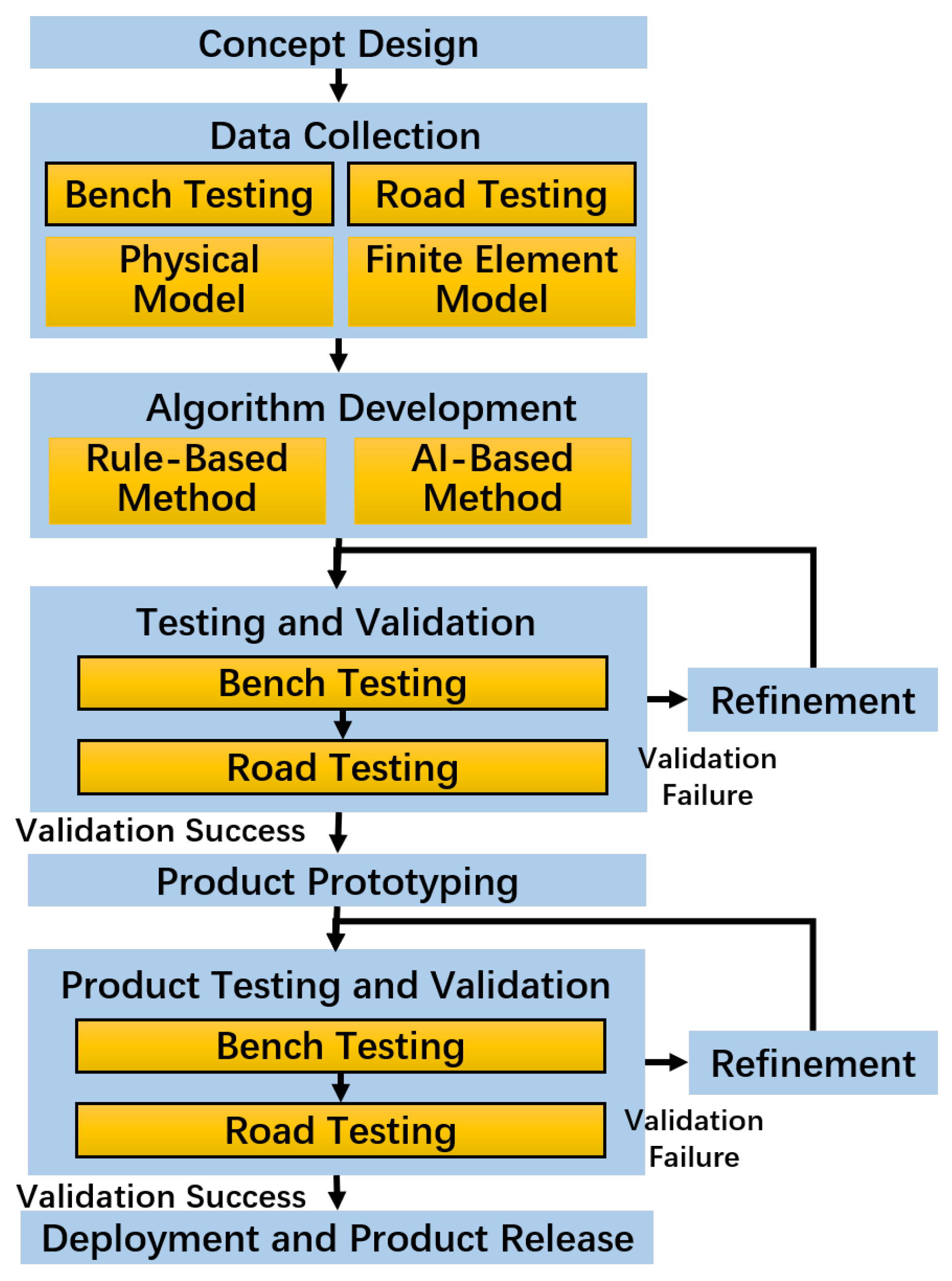
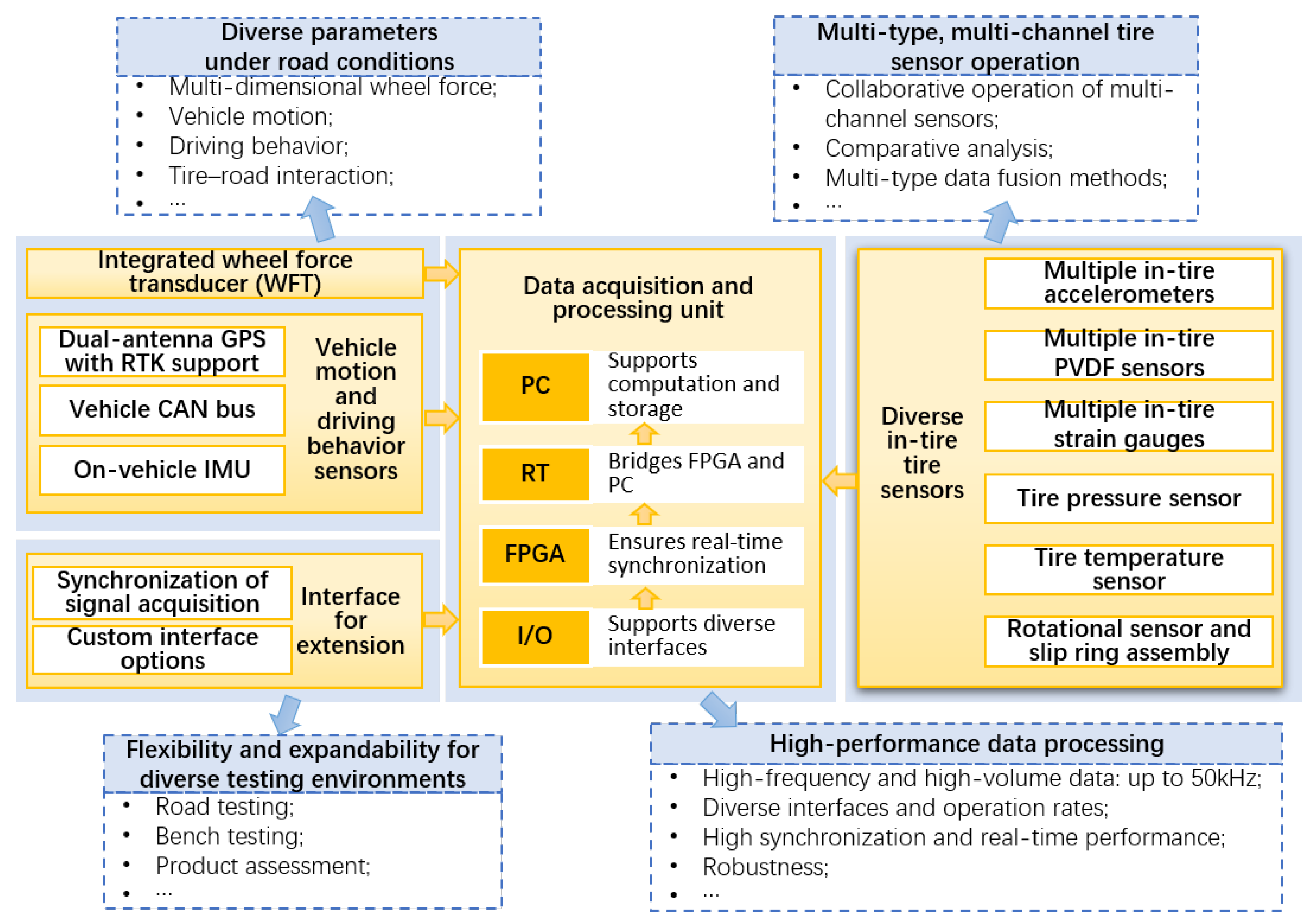
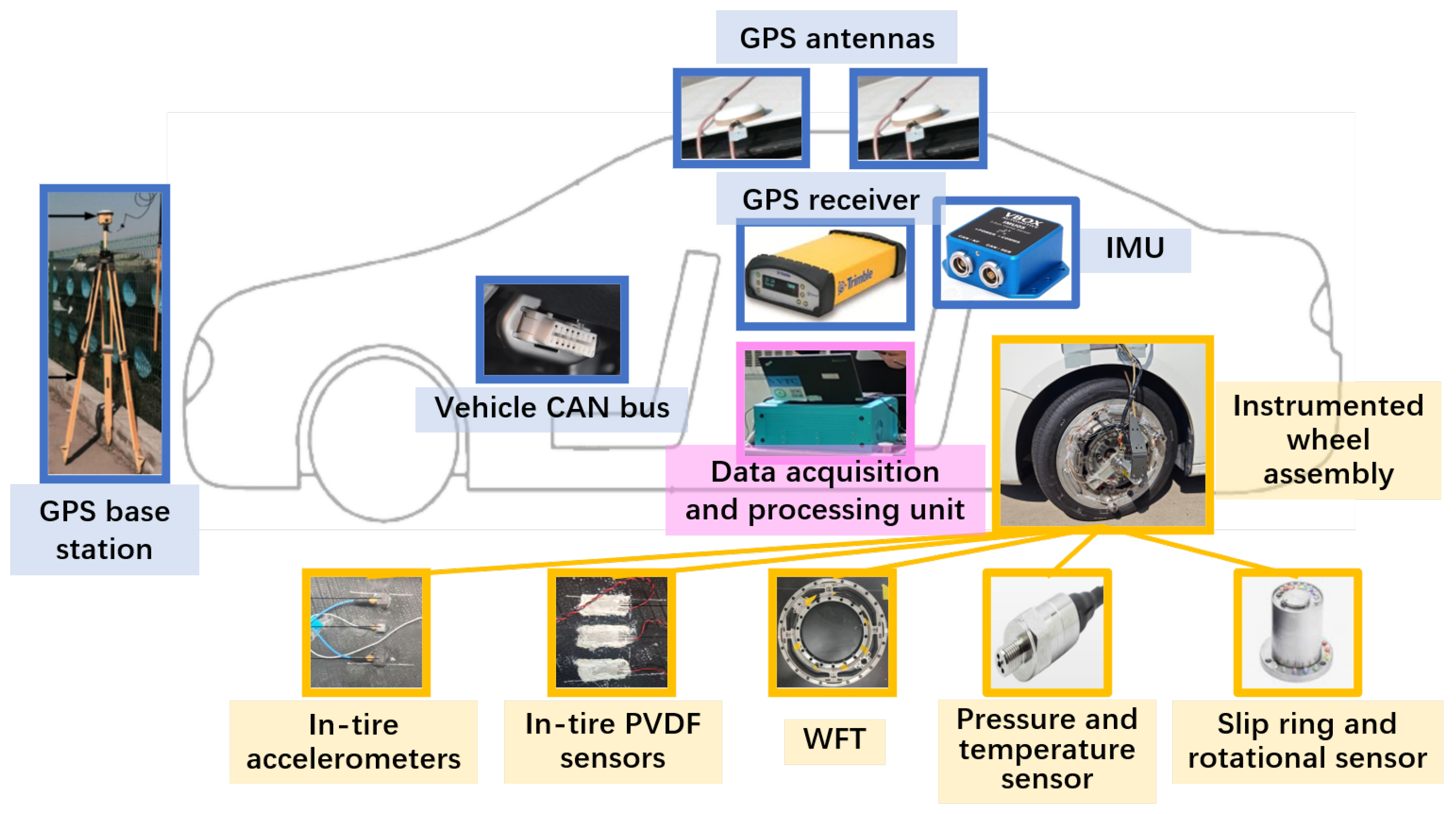
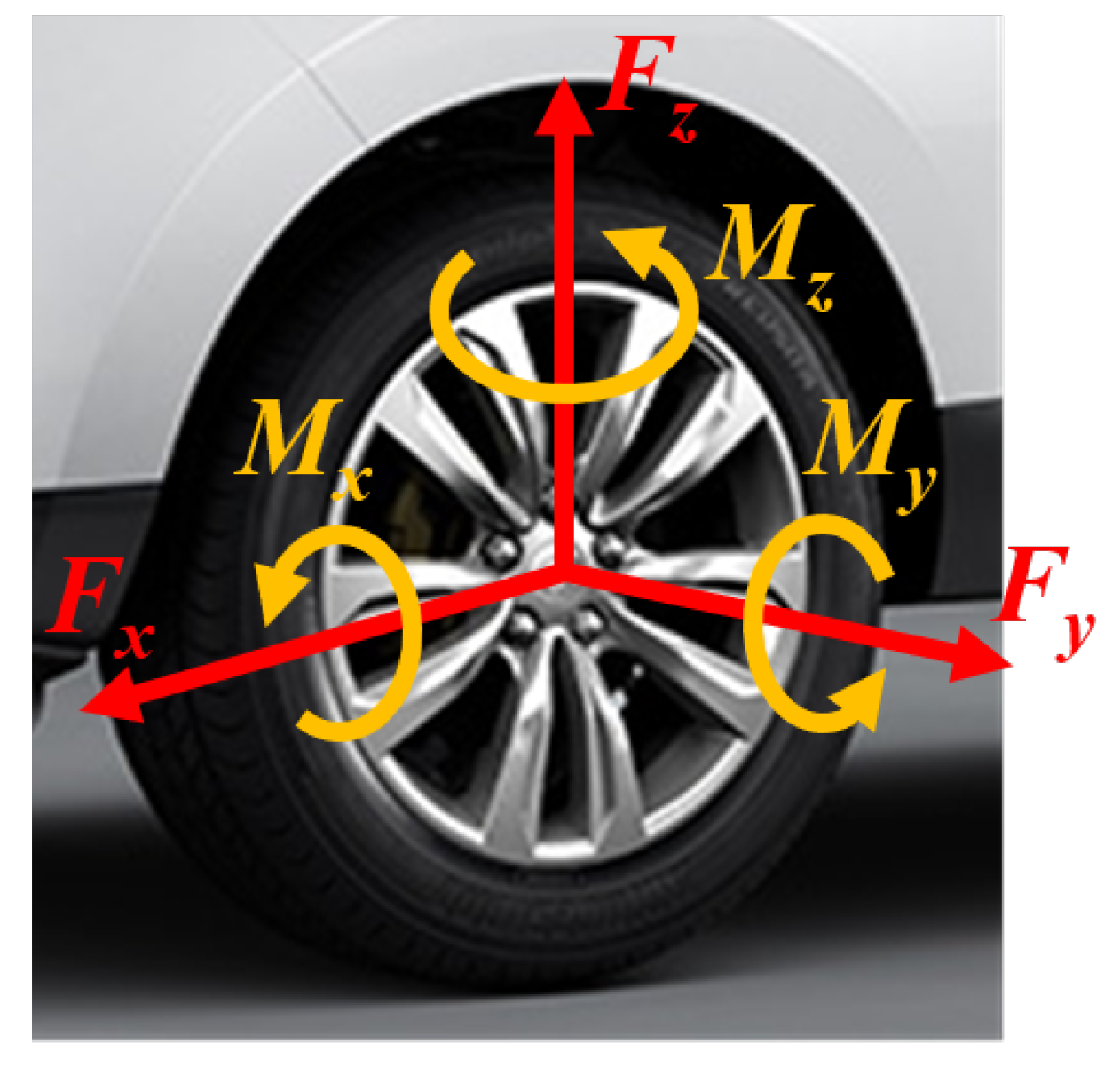



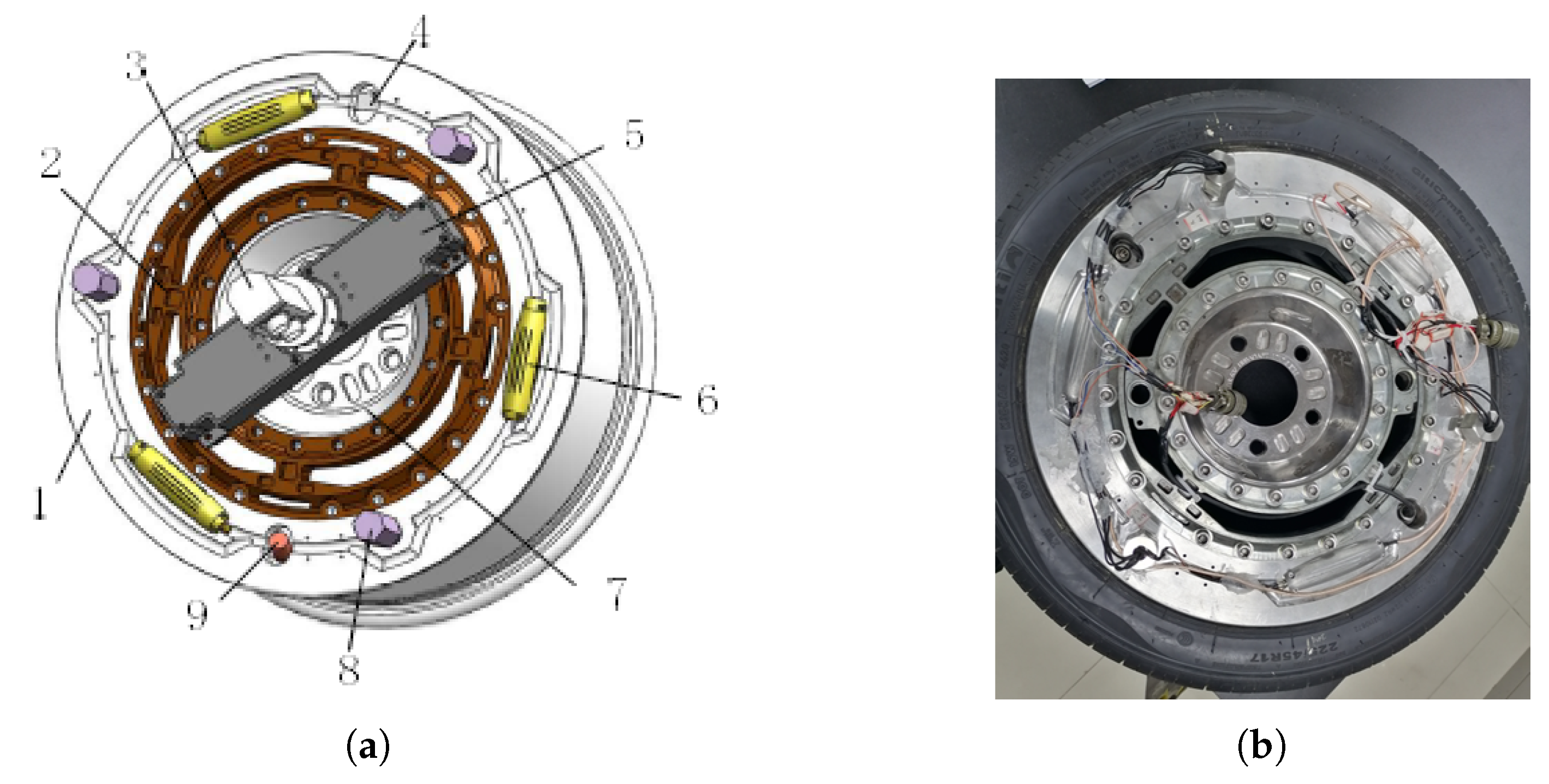

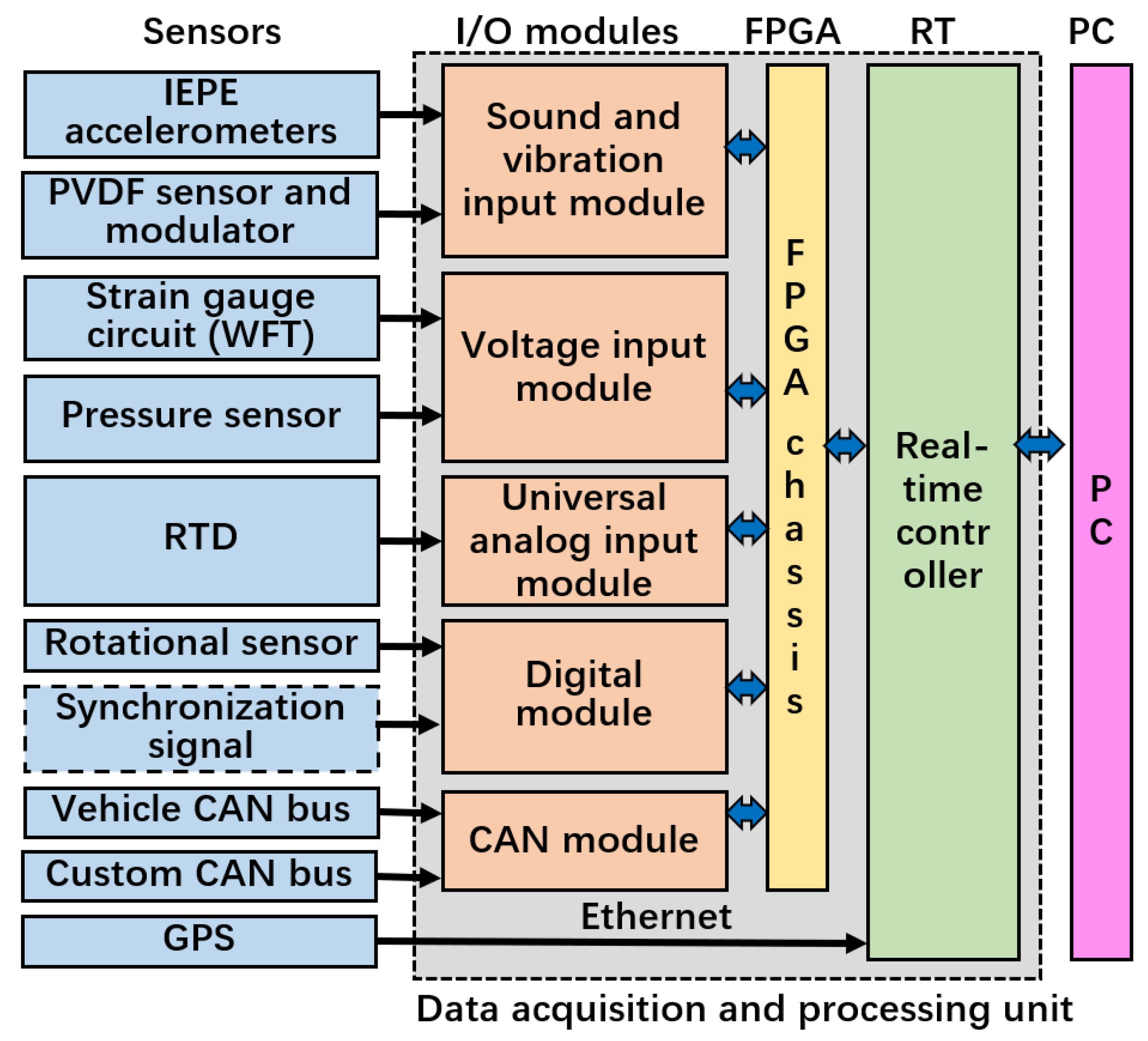

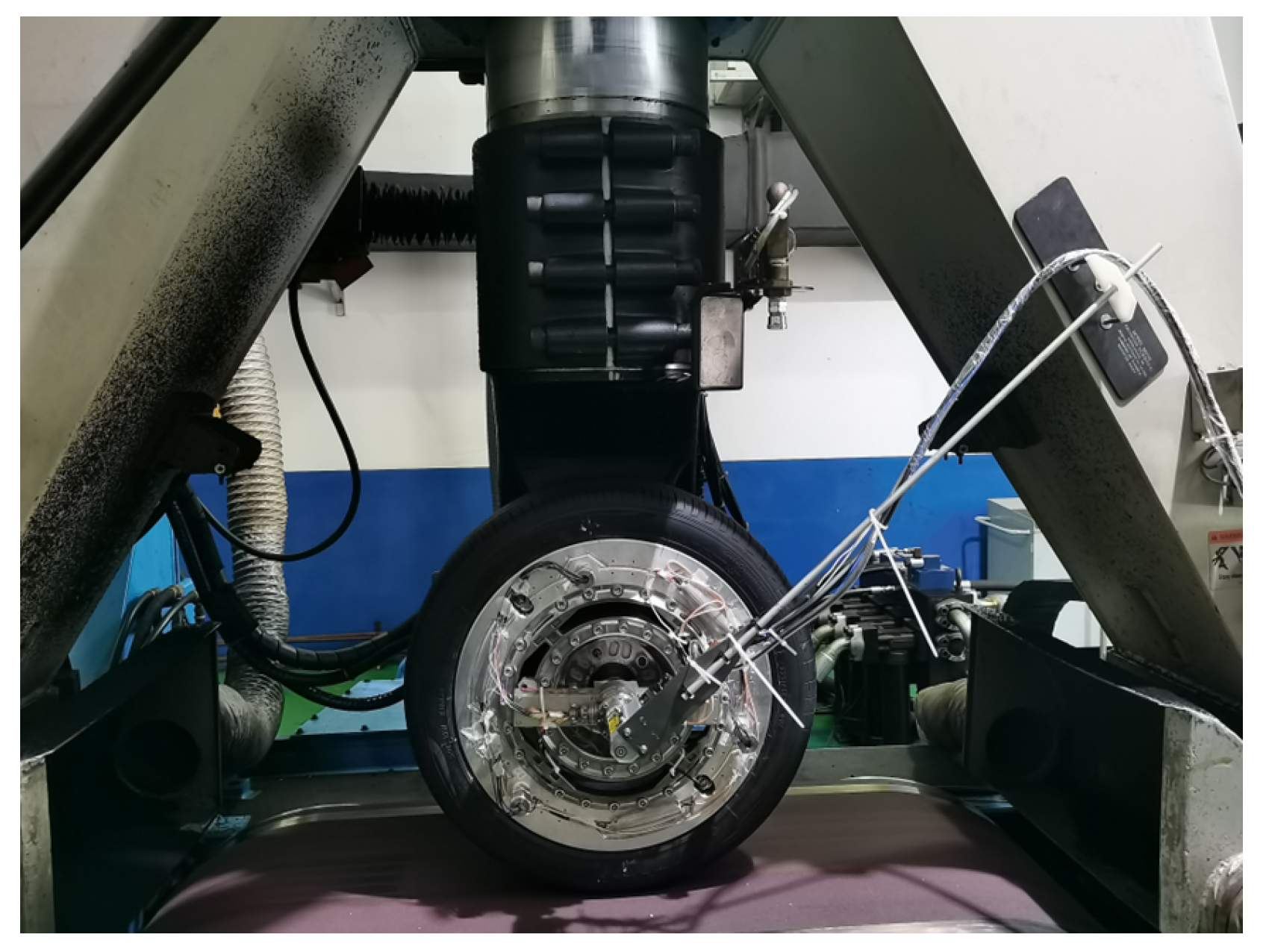
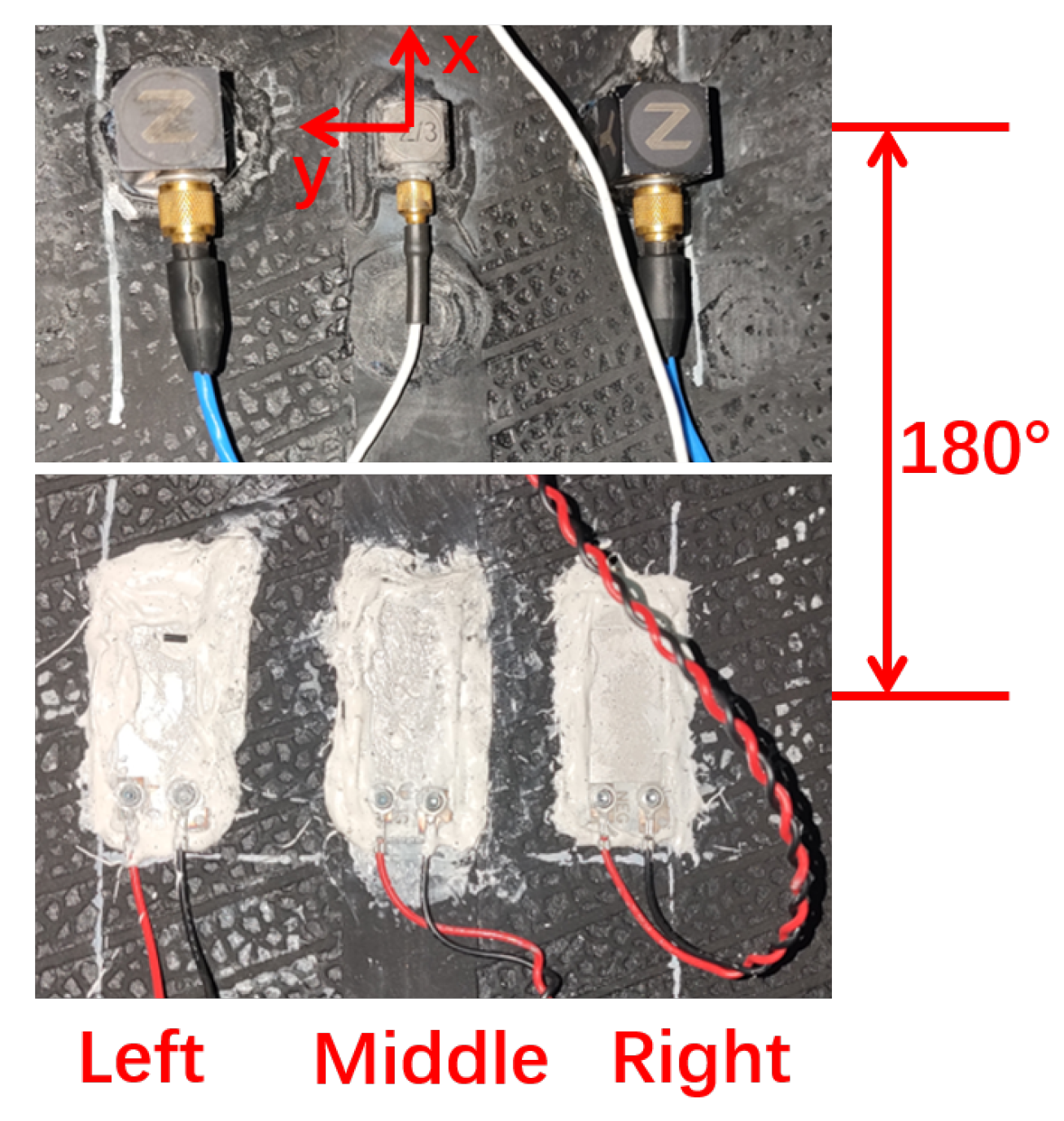

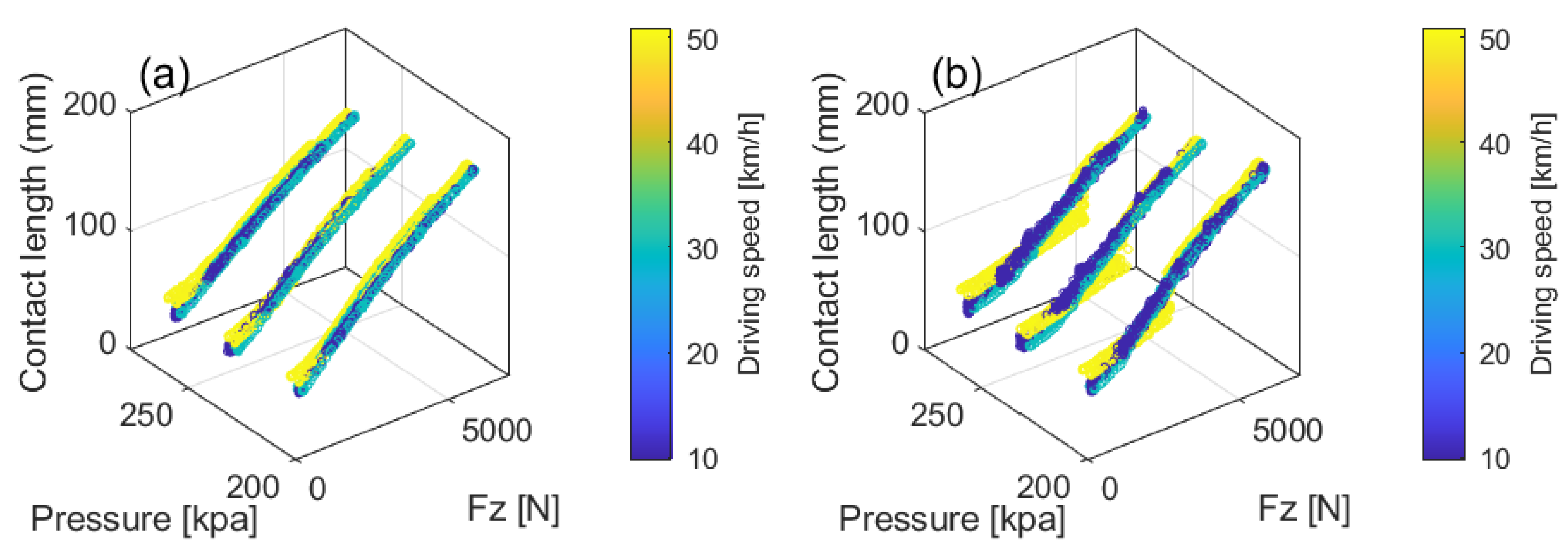


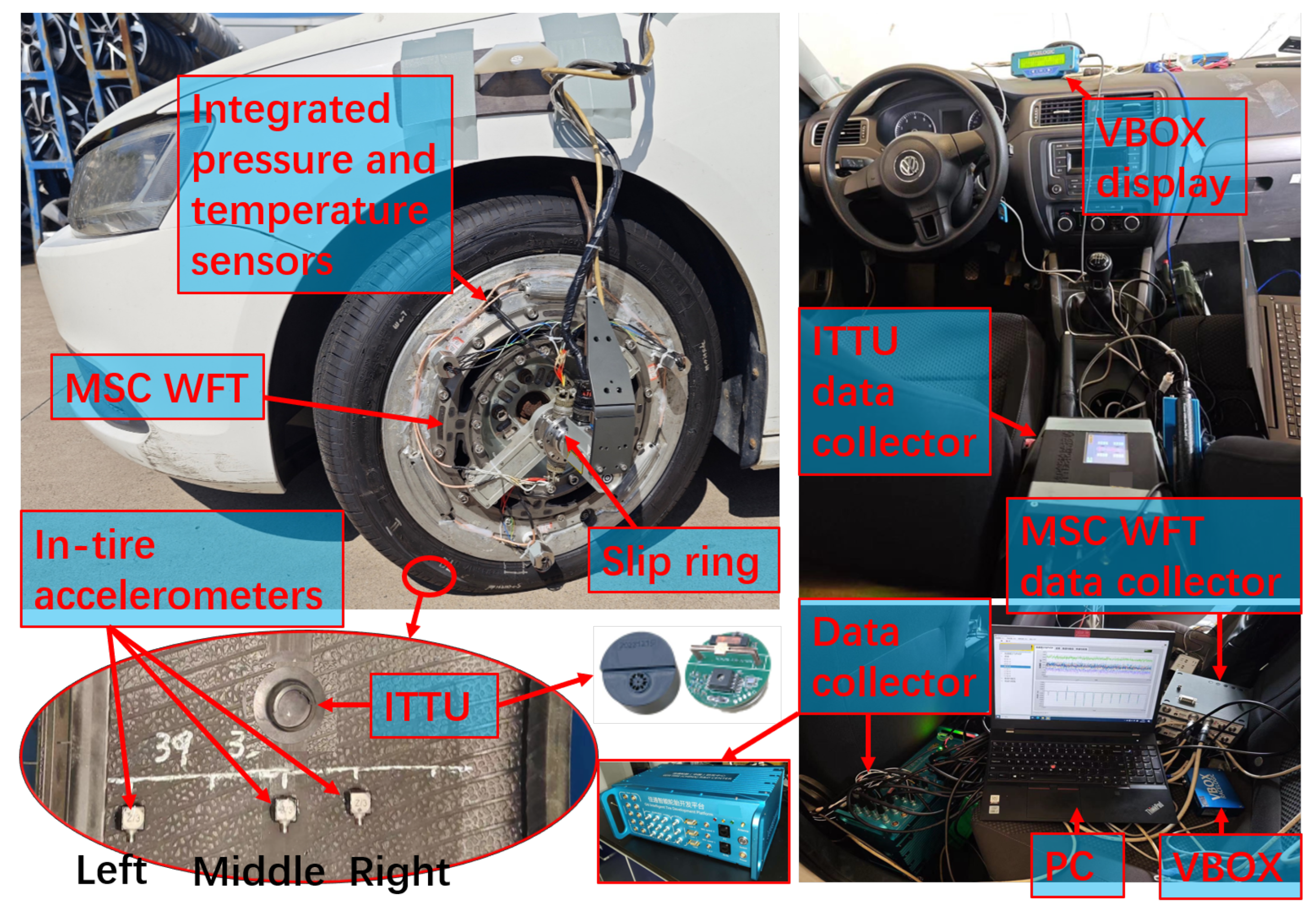
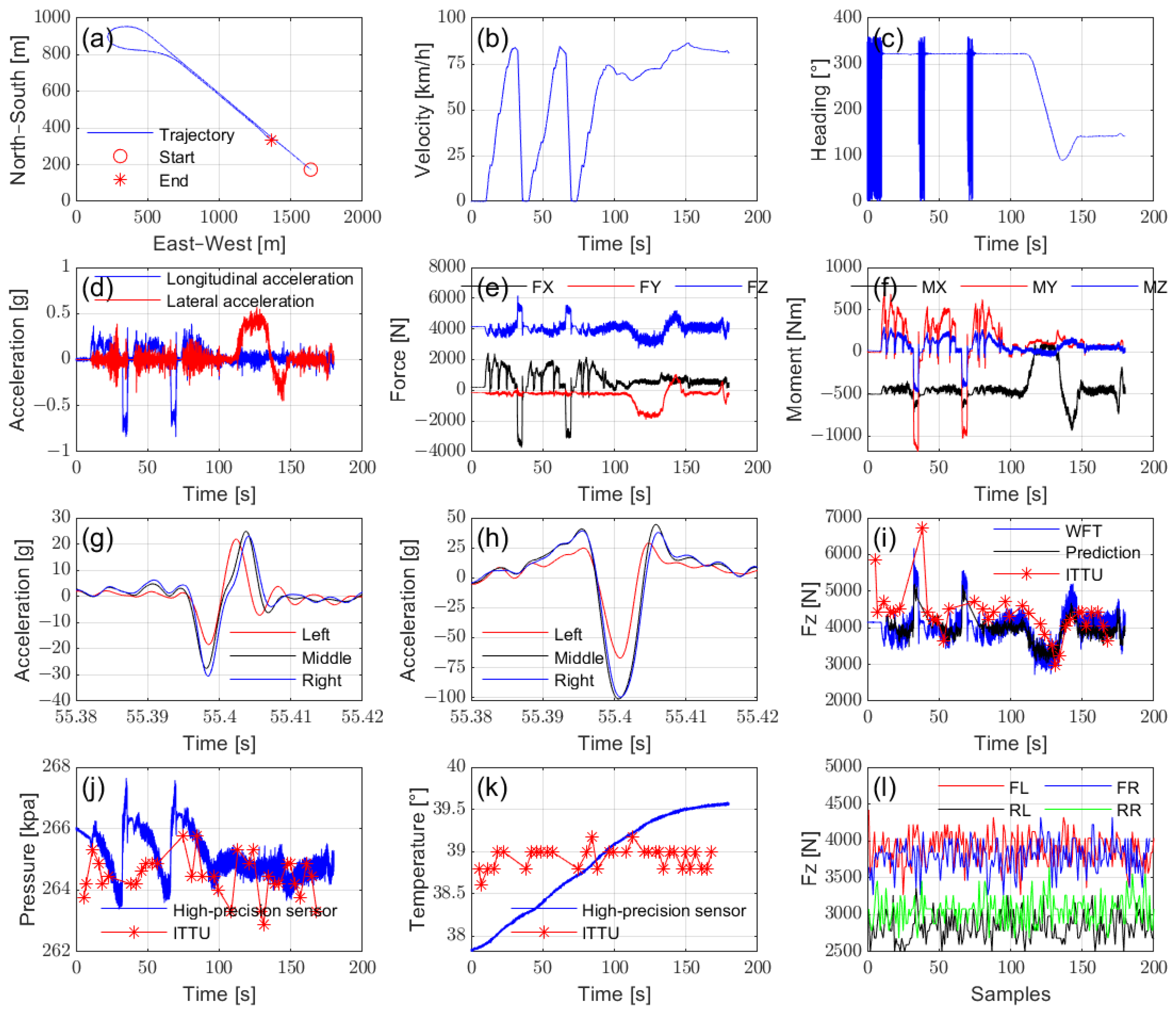
| Category | Parameter | Reference |
|---|---|---|
| Tire condition and performance | Pressure | [22] |
| Temperature | [35] | |
| Wear | [22,24] | |
| Rotation speed | [3] | |
| Tire–road interaction | Longitudinal force, | [3,19] |
| Lateral force, | [3,11,19] | |
| Vertical force, | [3,11,19,22,25] | |
| Aligning moment, | [11] | |
| Contact patch length | [11,25] | |
| Slip ratio | [3] | |
| Slip angle | [3,11,25] | |
| Vehicle motion and driving behaviors | Vehicle velocity | [3,22,25] |
| Acceleration | [3,19] | |
| Braking | [3,19] | |
| Turning | [3,19] | |
| Road condition | Friction coefficient | [11] |
| Road surface classification | [5] |
| Sensor | SVM (%) | Linear Regression (%) |
|---|---|---|
| Accelerometer | 3.7271 | 8.7771 |
| PVDF sensor | 4.0686 | 19.1354 |
Disclaimer/Publisher’s Note: The statements, opinions and data contained in all publications are solely those of the individual author(s) and contributor(s) and not of MDPI and/or the editor(s). MDPI and/or the editor(s) disclaim responsibility for any injury to people or property resulting from any ideas, methods, instructions or products referred to in the content. |
© 2025 by the authors. Licensee MDPI, Basel, Switzerland. This article is an open access article distributed under the terms and conditions of the Creative Commons Attribution (CC BY) license (https://creativecommons.org/licenses/by/4.0/).
Share and Cite
Wu, T.; Zhang, X.; Wang, D.; Zhang, W.; Pan, D.; Tao, L. Design and Implementation of Novel Testing System for Intelligent Tire Development: From Bench to Road. Sensors 2025, 25, 2430. https://doi.org/10.3390/s25082430
Wu T, Zhang X, Wang D, Zhang W, Pan D, Tao L. Design and Implementation of Novel Testing System for Intelligent Tire Development: From Bench to Road. Sensors. 2025; 25(8):2430. https://doi.org/10.3390/s25082430
Chicago/Turabian StyleWu, Ti, Xiaolong Zhang, Dong Wang, Weigong Zhang, Deng Pan, and Liang Tao. 2025. "Design and Implementation of Novel Testing System for Intelligent Tire Development: From Bench to Road" Sensors 25, no. 8: 2430. https://doi.org/10.3390/s25082430
APA StyleWu, T., Zhang, X., Wang, D., Zhang, W., Pan, D., & Tao, L. (2025). Design and Implementation of Novel Testing System for Intelligent Tire Development: From Bench to Road. Sensors, 25(8), 2430. https://doi.org/10.3390/s25082430






